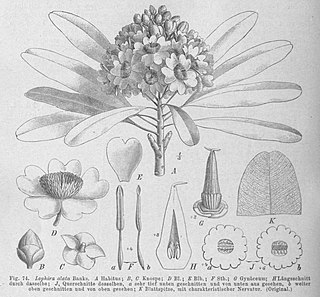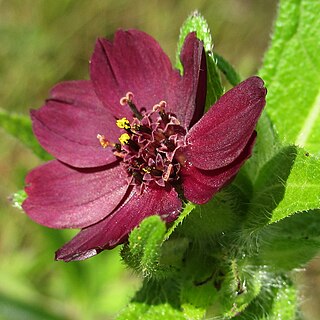
Uncaria is a genus of flowering plants in the family Rubiaceae. It has about 40 species. Their distribution is pantropical, with most species native to tropical Asia, three from Africa and the Mediterranean and two from the neotropics. They are known colloquially as gambier, cat's claw or uña de gato. The latter two names are shared with several other plants. The type species for the genus is Uncaria guianensis.

Aralia spinosa, commonly known as devil's walking stick, is a woody species of plant in the genus Aralia, family Araliaceae, native to eastern North America. The various names refer to the viciously sharp, spiny stems, petioles, and even leaf midribs. It has also been known as Angelica-tree.

Terminalia catappa is a large tropical tree in the leadwood tree family, Combretaceae, native to Asia, Australia, the Pacific, Madagascar and Seychelles. Common names in English include country almond, Indian almond, Malabar almond, sea almond, tropical almond, beach almond and false kamani.

Couroupita guianensis, known by a variety of common names including cannonball tree, is a deciduous tree in the flowering plant family Lecythidaceae. It is native to the tropical forests of Central and South America, and it is cultivated in many other tropical areas throughout the world because of its beautiful, fragrant flowers and large, interesting fruits. Fruits are brownish grey. There are potential medicinal uses for many parts of Couroupita guianensis, and the tree has cultural and religious significance in India. In Sri Lanka, the cannonball tree has been widely misidentified as Sal, after its introduction to the island by the British in 1881, and has been included as a common item in Buddhist temples as a result.

Lagerstroemia speciosa is a species of Lagerstroemia native to tropical southern Asia. It is a deciduous tree with bright pink to light purple flowers.

Kigelia is a genus of flowering plants in the family Bignoniaceae. The genus consists of only one species, Kigelia africana, which occurs throughout tropical Africa. The so-called sausage tree grows a poisonous fruit that is up to 60 cm long, weighs about 7 kg, and resembles a sausage in a casing.

Prunus africana, the African cherry, has a wide distribution in Africa, occurring in montane regions of central and southern Africa and on the islands of Bioko, São-Tomé, Grande Comore, and Madagascar. It can be found at 900–3,400 m (3,000–10,000 ft) above sea level. It is a canopy tree 30–40 m in height, and is the tallest member of Prunus. Large-diameter trees have impressive, spreading crowns. It requires a moist climate, 900–3,400 mm (35–130 in) annual rainfall, and is moderately frost-tolerant. P. africana appears to be a light-demanding, secondary-forest species.

Voacanga africana is a small tree native to tropical Africa belonging to the family Apocynaceae that grows to 6 m (20 ft) in height and bears leaves that are up to 30 cm (12 in) in length. The yellow or white flowers are succeeded by paired, follicular, dehiscent fruit with a mottled green exocarp and a pulpy, yellow mesocarp surrounding the seeds. The plant contains alkaloids acting as CNS depressants and hypotensives
Terminalia schimperiana is a species of Terminalia, native to tropical Africa from Guinea and Sierra Leone east to Uganda and Ethiopia.

Dichrostachys cinerea, known as sicklebush, Bell mimosa, Chinese lantern tree or Kalahari Christmas tree, is a legume of the genus Dichrostachys in the family Fabaceae.

Guilandina bonduc, commonly known as grey nicker, nicker bean, fever nut or knicker nut, is a species of flowering plant in the senna tribe, Caesalpinieae, that has a pantropical distribution. It is a liana that reaches a length of 6 m (20 ft) or more and scrambles over other vegetation. The stems are covered in curved spines. Its 2 cm (0.8 in) grey seeds, known as nickernuts, are buoyant and durable enough to be dispersed by ocean currents.

Acalypha indica is an herbaceous annual that has catkin-like inflorescences with cup-shaped involucres surrounding the minute flowers. It is mainly known for its root being attractive to domestic cats, and for its various medicinal uses. It occurs throughout the Tropics.

Treculia africana is a tree species in the genus Treculia which can be used as a food plant and for various other traditional uses. The fruits are hard and fibrous, can be the size of a volleyball and weight up to 8.5 kg (19 lb). Chimpanzees have been observed to use tools to break the fruits into small pieces that they can eat. The fruits contain polyphenols.

Dolichandra unguis-cati, commonly known as cat's claw creeper, funnel creeper, or cat's claw trumpet, is a rapidly growing climbing vine belonging to the family Bignoniaceae. It affects all plant layers of the forest ecosystem spreading rapidly both vertically and horizontally.

Newtonia hildebrandtii, the Lebombo wattle, is a medium-sized tree native to eastern Africa. It is a protected tree in South Africa.

Sterculia africana or African star-chestnut is a deciduous tree, belonging to the genus Sterculia and the family Malvaceae. The species is sometimes called the "mopopaja tree". It is distributed throughout Northeast Africa to Arabia.

Lophira lanceolata, commonly known as the dwarf red ironwood, is a species of tree in the family Ochnaceae which is native to tropical West and Central Africa. The timber is used for heavy construction, an edible oil can be extracted from the seeds and various parts of the plant are used in traditional medicine.
Erythrophleum couminga is a species of leguminous tree in the genus Erythrophleum. It is endemic to the western coastal region of Madagascar, occurring in the Baie de Baly National Park. The bark is used in traditional medicine and the branches are used for fencing posts.

Aspilia kotschyi is an annual herbaceous species with ovate to narrowly lanceolate leaves and dark red-purple flowers commonly found Tropical Africa. It has a variety, Aspilia kotschyi var. alba which has white flowers.
Mammea africana is a medium to large sized tree within the family Calophyllaceae, it is also known as African mammee apple and its timber is traded under the trade name, Oboto. Mammea africana is found in evergreen and semi deciduous forests in West and Central Tropical Africa.

















